BEO6600: Analyzing Minimum Wage, Efficiency Wages and Business
VerifiedAdded on 2023/06/11
|8
|1389
|142
Report
AI Summary
This report examines the impact of minimum wage on business viability in Australia, focusing on the rationale behind minimum wage based on efficiency wage theory, the disadvantages and problems associated with a binding minimum wage for employers in the labor market and the economy, and strategic recommendations for new business setups in Australia. The report discusses how minimum wage, often set by labor unions or the government, aims to enhance worker productivity and efficiency. It explores the benefits of higher wages, such as reduced worker turnover and increased worker quality, while also addressing the drawbacks, including involuntary unemployment and the vulnerability of labor-intensive industries. Furthermore, it analyzes the specific context of Australia, where the minimum wage is relatively high, and offers strategic recommendations for businesses to adapt to these conditions, such as adopting labor-saving technologies and maximizing productivity gains. The report concludes by emphasizing the importance of businesses being aware of minimum wage laws and designing their budgets accordingly to maintain profitability.

Running Head: BUSINESS ECONOMICS
Business Economics
Name of the Student
Name of the University
Course ID
Business Economics
Name of the Student
Name of the University
Course ID
Paraphrase This Document
Need a fresh take? Get an instant paraphrase of this document with our AI Paraphraser
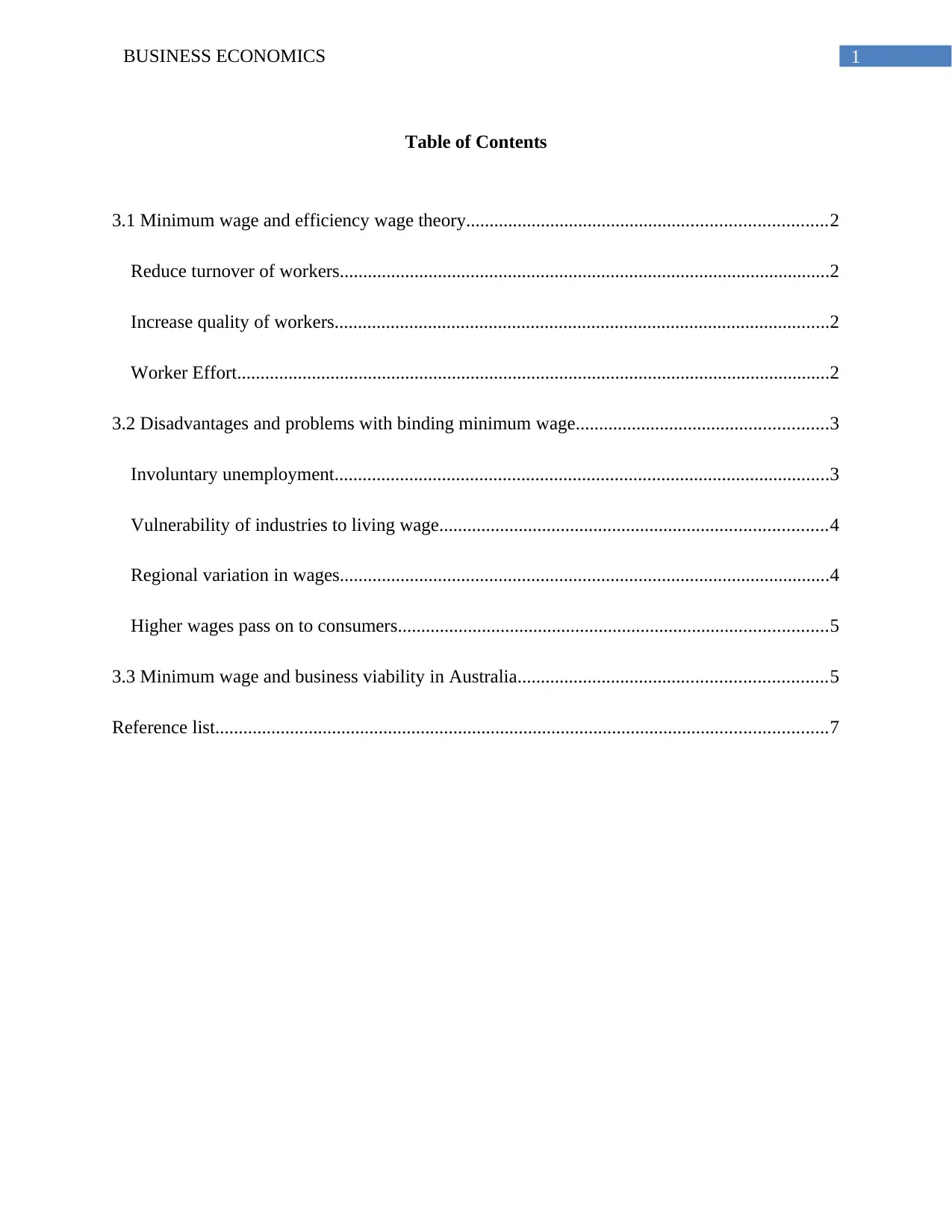
1BUSINESS ECONOMICS
Table of Contents
3.1 Minimum wage and efficiency wage theory.............................................................................2
Reduce turnover of workers.........................................................................................................2
Increase quality of workers..........................................................................................................2
Worker Effort...............................................................................................................................2
3.2 Disadvantages and problems with binding minimum wage......................................................3
Involuntary unemployment..........................................................................................................3
Vulnerability of industries to living wage...................................................................................4
Regional variation in wages.........................................................................................................4
Higher wages pass on to consumers............................................................................................5
3.3 Minimum wage and business viability in Australia..................................................................5
Reference list...................................................................................................................................7
Table of Contents
3.1 Minimum wage and efficiency wage theory.............................................................................2
Reduce turnover of workers.........................................................................................................2
Increase quality of workers..........................................................................................................2
Worker Effort...............................................................................................................................2
3.2 Disadvantages and problems with binding minimum wage......................................................3
Involuntary unemployment..........................................................................................................3
Vulnerability of industries to living wage...................................................................................4
Regional variation in wages.........................................................................................................4
Higher wages pass on to consumers............................................................................................5
3.3 Minimum wage and business viability in Australia..................................................................5
Reference list...................................................................................................................................7

2BUSINESS ECONOMICS
3.1 Minimum wage and efficiency wage theory
Labor union or government often set a minimum wage if equilibrium wage is too low to
fulfill necessities of laborers. The minimum wage is also called efficiency wage as it enhances
workers’ productivity and efficiency. The standard theory stating need for paying wage above
the market-clearing wage is known as theory of Efficiency – Wage (Greenwood 2016). The
theory suggests a number of reason in support of a higher wage.
Reduce turnover of workers
In most instances, workers joining new jobs are unaware of various things such as
specific job types, efficiently working with the organization and the like. Firms have to spend
significant amount of time and money to make the new workers fully productive. Firms also
need to bear a large expense for hiring and recruiting new workers (Keynes 2016). This makes
workers’ turnover costly. Turnover can be reduced by offering workers a higher payment. With a
higher payment received from existing job it becomes difficult for workers to find alternative
jobs with equivalent pay.
Increase quality of workers
Wages above the market clearing wage results in an improvement in quality of workers.
Quality of workers increases in two ways. First, when companies offer a higher wage, there are
applicants that are more qualified and it becomes easy for firms to hire talented and skilled
workers. Second, high paid workers can take a better care of themselves in form of a more
nutritious diet, sleep and others (Benjamin 2015). The healthier workers are more productive
than unhealthy ones.
Worker Effort
3.1 Minimum wage and efficiency wage theory
Labor union or government often set a minimum wage if equilibrium wage is too low to
fulfill necessities of laborers. The minimum wage is also called efficiency wage as it enhances
workers’ productivity and efficiency. The standard theory stating need for paying wage above
the market-clearing wage is known as theory of Efficiency – Wage (Greenwood 2016). The
theory suggests a number of reason in support of a higher wage.
Reduce turnover of workers
In most instances, workers joining new jobs are unaware of various things such as
specific job types, efficiently working with the organization and the like. Firms have to spend
significant amount of time and money to make the new workers fully productive. Firms also
need to bear a large expense for hiring and recruiting new workers (Keynes 2016). This makes
workers’ turnover costly. Turnover can be reduced by offering workers a higher payment. With a
higher payment received from existing job it becomes difficult for workers to find alternative
jobs with equivalent pay.
Increase quality of workers
Wages above the market clearing wage results in an improvement in quality of workers.
Quality of workers increases in two ways. First, when companies offer a higher wage, there are
applicants that are more qualified and it becomes easy for firms to hire talented and skilled
workers. Second, high paid workers can take a better care of themselves in form of a more
nutritious diet, sleep and others (Benjamin 2015). The healthier workers are more productive
than unhealthy ones.
Worker Effort
⊘ This is a preview!⊘
Do you want full access?
Subscribe today to unlock all pages.

Trusted by 1+ million students worldwide
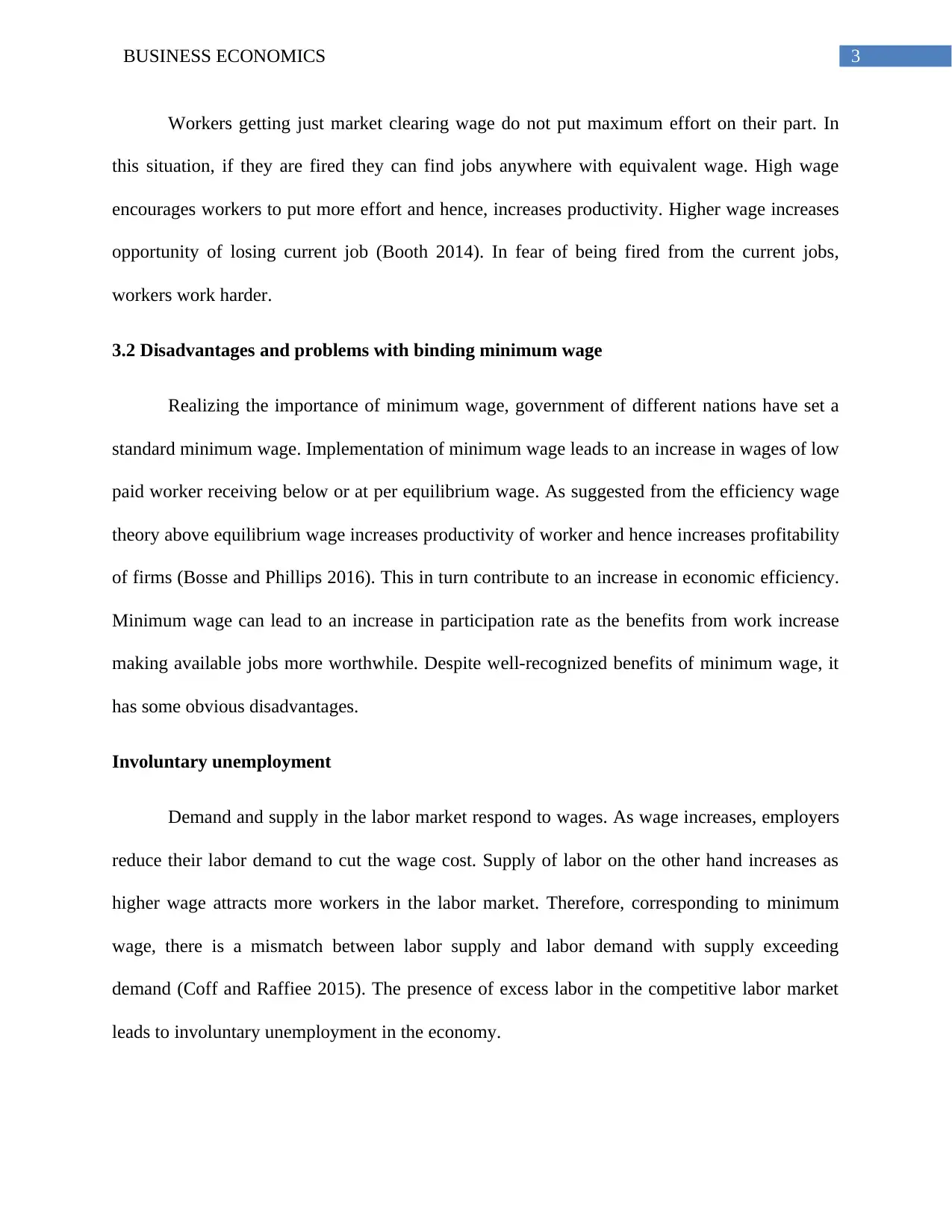
3BUSINESS ECONOMICS
Workers getting just market clearing wage do not put maximum effort on their part. In
this situation, if they are fired they can find jobs anywhere with equivalent wage. High wage
encourages workers to put more effort and hence, increases productivity. Higher wage increases
opportunity of losing current job (Booth 2014). In fear of being fired from the current jobs,
workers work harder.
3.2 Disadvantages and problems with binding minimum wage
Realizing the importance of minimum wage, government of different nations have set a
standard minimum wage. Implementation of minimum wage leads to an increase in wages of low
paid worker receiving below or at per equilibrium wage. As suggested from the efficiency wage
theory above equilibrium wage increases productivity of worker and hence increases profitability
of firms (Bosse and Phillips 2016). This in turn contribute to an increase in economic efficiency.
Minimum wage can lead to an increase in participation rate as the benefits from work increase
making available jobs more worthwhile. Despite well-recognized benefits of minimum wage, it
has some obvious disadvantages.
Involuntary unemployment
Demand and supply in the labor market respond to wages. As wage increases, employers
reduce their labor demand to cut the wage cost. Supply of labor on the other hand increases as
higher wage attracts more workers in the labor market. Therefore, corresponding to minimum
wage, there is a mismatch between labor supply and labor demand with supply exceeding
demand (Coff and Raffiee 2015). The presence of excess labor in the competitive labor market
leads to involuntary unemployment in the economy.
Workers getting just market clearing wage do not put maximum effort on their part. In
this situation, if they are fired they can find jobs anywhere with equivalent wage. High wage
encourages workers to put more effort and hence, increases productivity. Higher wage increases
opportunity of losing current job (Booth 2014). In fear of being fired from the current jobs,
workers work harder.
3.2 Disadvantages and problems with binding minimum wage
Realizing the importance of minimum wage, government of different nations have set a
standard minimum wage. Implementation of minimum wage leads to an increase in wages of low
paid worker receiving below or at per equilibrium wage. As suggested from the efficiency wage
theory above equilibrium wage increases productivity of worker and hence increases profitability
of firms (Bosse and Phillips 2016). This in turn contribute to an increase in economic efficiency.
Minimum wage can lead to an increase in participation rate as the benefits from work increase
making available jobs more worthwhile. Despite well-recognized benefits of minimum wage, it
has some obvious disadvantages.
Involuntary unemployment
Demand and supply in the labor market respond to wages. As wage increases, employers
reduce their labor demand to cut the wage cost. Supply of labor on the other hand increases as
higher wage attracts more workers in the labor market. Therefore, corresponding to minimum
wage, there is a mismatch between labor supply and labor demand with supply exceeding
demand (Coff and Raffiee 2015). The presence of excess labor in the competitive labor market
leads to involuntary unemployment in the economy.
Paraphrase This Document
Need a fresh take? Get an instant paraphrase of this document with our AI Paraphraser
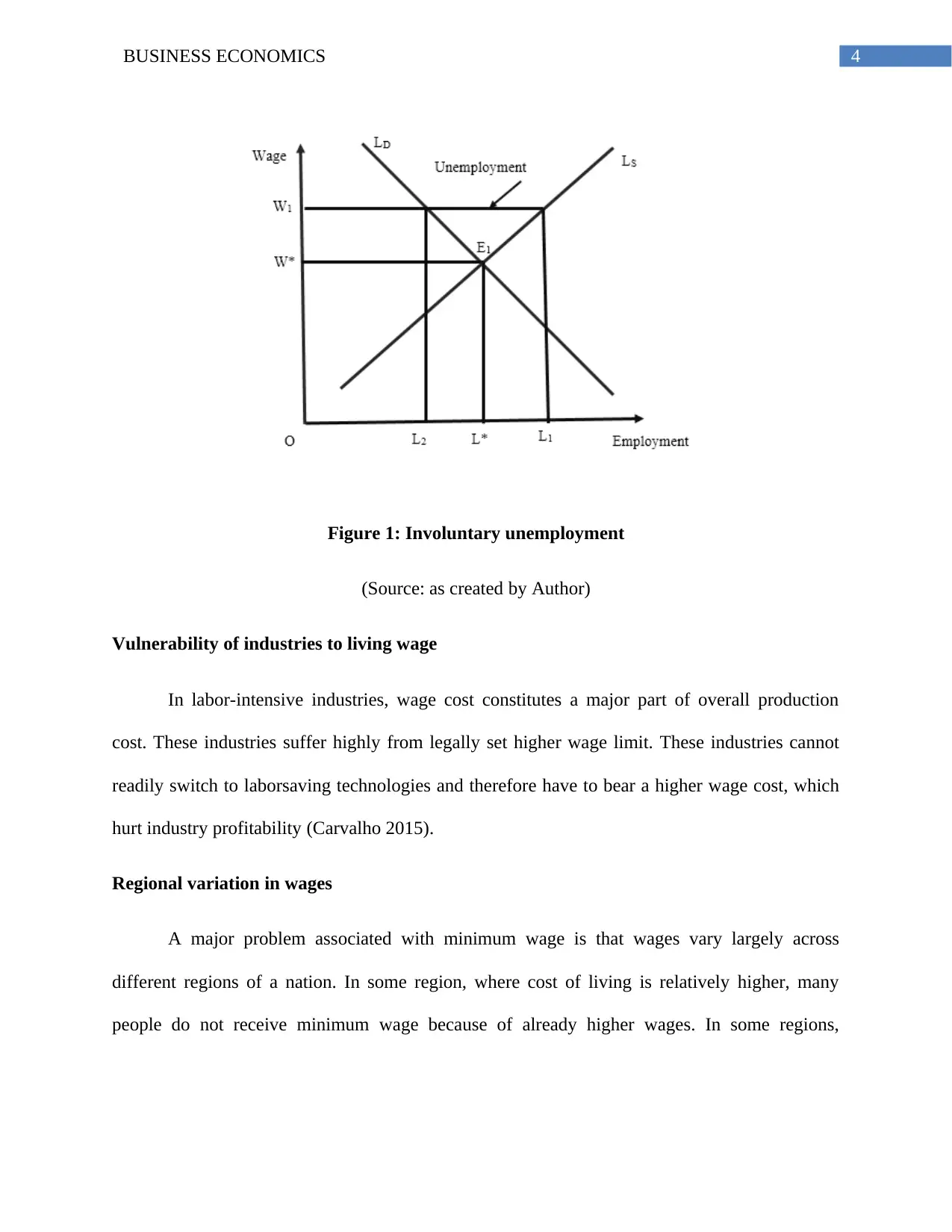
4BUSINESS ECONOMICS
Figure 1: Involuntary unemployment
(Source: as created by Author)
Vulnerability of industries to living wage
In labor-intensive industries, wage cost constitutes a major part of overall production
cost. These industries suffer highly from legally set higher wage limit. These industries cannot
readily switch to laborsaving technologies and therefore have to bear a higher wage cost, which
hurt industry profitability (Carvalho 2015).
Regional variation in wages
A major problem associated with minimum wage is that wages vary largely across
different regions of a nation. In some region, where cost of living is relatively higher, many
people do not receive minimum wage because of already higher wages. In some regions,
Figure 1: Involuntary unemployment
(Source: as created by Author)
Vulnerability of industries to living wage
In labor-intensive industries, wage cost constitutes a major part of overall production
cost. These industries suffer highly from legally set higher wage limit. These industries cannot
readily switch to laborsaving technologies and therefore have to bear a higher wage cost, which
hurt industry profitability (Carvalho 2015).
Regional variation in wages
A major problem associated with minimum wage is that wages vary largely across
different regions of a nation. In some region, where cost of living is relatively higher, many
people do not receive minimum wage because of already higher wages. In some regions,
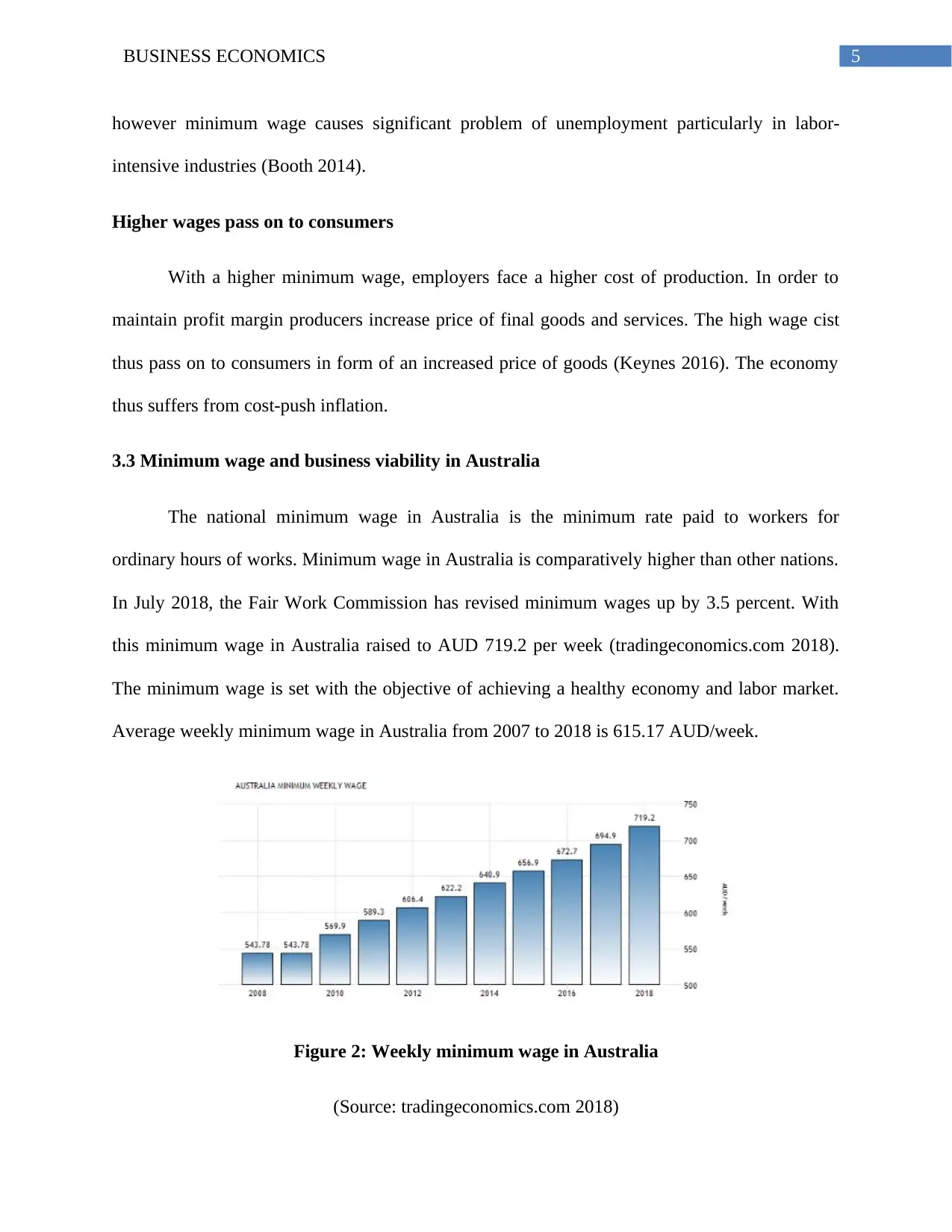
5BUSINESS ECONOMICS
however minimum wage causes significant problem of unemployment particularly in labor-
intensive industries (Booth 2014).
Higher wages pass on to consumers
With a higher minimum wage, employers face a higher cost of production. In order to
maintain profit margin producers increase price of final goods and services. The high wage cist
thus pass on to consumers in form of an increased price of goods (Keynes 2016). The economy
thus suffers from cost-push inflation.
3.3 Minimum wage and business viability in Australia
The national minimum wage in Australia is the minimum rate paid to workers for
ordinary hours of works. Minimum wage in Australia is comparatively higher than other nations.
In July 2018, the Fair Work Commission has revised minimum wages up by 3.5 percent. With
this minimum wage in Australia raised to AUD 719.2 per week (tradingeconomics.com 2018).
The minimum wage is set with the objective of achieving a healthy economy and labor market.
Average weekly minimum wage in Australia from 2007 to 2018 is 615.17 AUD/week.
Figure 2: Weekly minimum wage in Australia
(Source: tradingeconomics.com 2018)
however minimum wage causes significant problem of unemployment particularly in labor-
intensive industries (Booth 2014).
Higher wages pass on to consumers
With a higher minimum wage, employers face a higher cost of production. In order to
maintain profit margin producers increase price of final goods and services. The high wage cist
thus pass on to consumers in form of an increased price of goods (Keynes 2016). The economy
thus suffers from cost-push inflation.
3.3 Minimum wage and business viability in Australia
The national minimum wage in Australia is the minimum rate paid to workers for
ordinary hours of works. Minimum wage in Australia is comparatively higher than other nations.
In July 2018, the Fair Work Commission has revised minimum wages up by 3.5 percent. With
this minimum wage in Australia raised to AUD 719.2 per week (tradingeconomics.com 2018).
The minimum wage is set with the objective of achieving a healthy economy and labor market.
Average weekly minimum wage in Australia from 2007 to 2018 is 615.17 AUD/week.
Figure 2: Weekly minimum wage in Australia
(Source: tradingeconomics.com 2018)
⊘ This is a preview!⊘
Do you want full access?
Subscribe today to unlock all pages.

Trusted by 1+ million students worldwide

6BUSINESS ECONOMICS
Rising wage cost is the biggest concern for firms especially for startup firms as it significantly
hurts business profitability. Start-up businesses in Australia should be well aware of the
minimum wage law and then should design its budget. With the presence of a higher minimum
wage, firms should try to adapt labor saving technology. In case the business is labor intensive, it
should try to minimize its expenses in other areas. Businesses should fully utilize the
productivity gain from minimum wage and attain a higher profitability (Bell and Machin 2018).
Firms can adapt automation techniques to substitute labors and save wage cost. Adapting the
alternative strategies business can survive by maintaining a minimum profit.
Rising wage cost is the biggest concern for firms especially for startup firms as it significantly
hurts business profitability. Start-up businesses in Australia should be well aware of the
minimum wage law and then should design its budget. With the presence of a higher minimum
wage, firms should try to adapt labor saving technology. In case the business is labor intensive, it
should try to minimize its expenses in other areas. Businesses should fully utilize the
productivity gain from minimum wage and attain a higher profitability (Bell and Machin 2018).
Firms can adapt automation techniques to substitute labors and save wage cost. Adapting the
alternative strategies business can survive by maintaining a minimum profit.
Paraphrase This Document
Need a fresh take? Get an instant paraphrase of this document with our AI Paraphraser
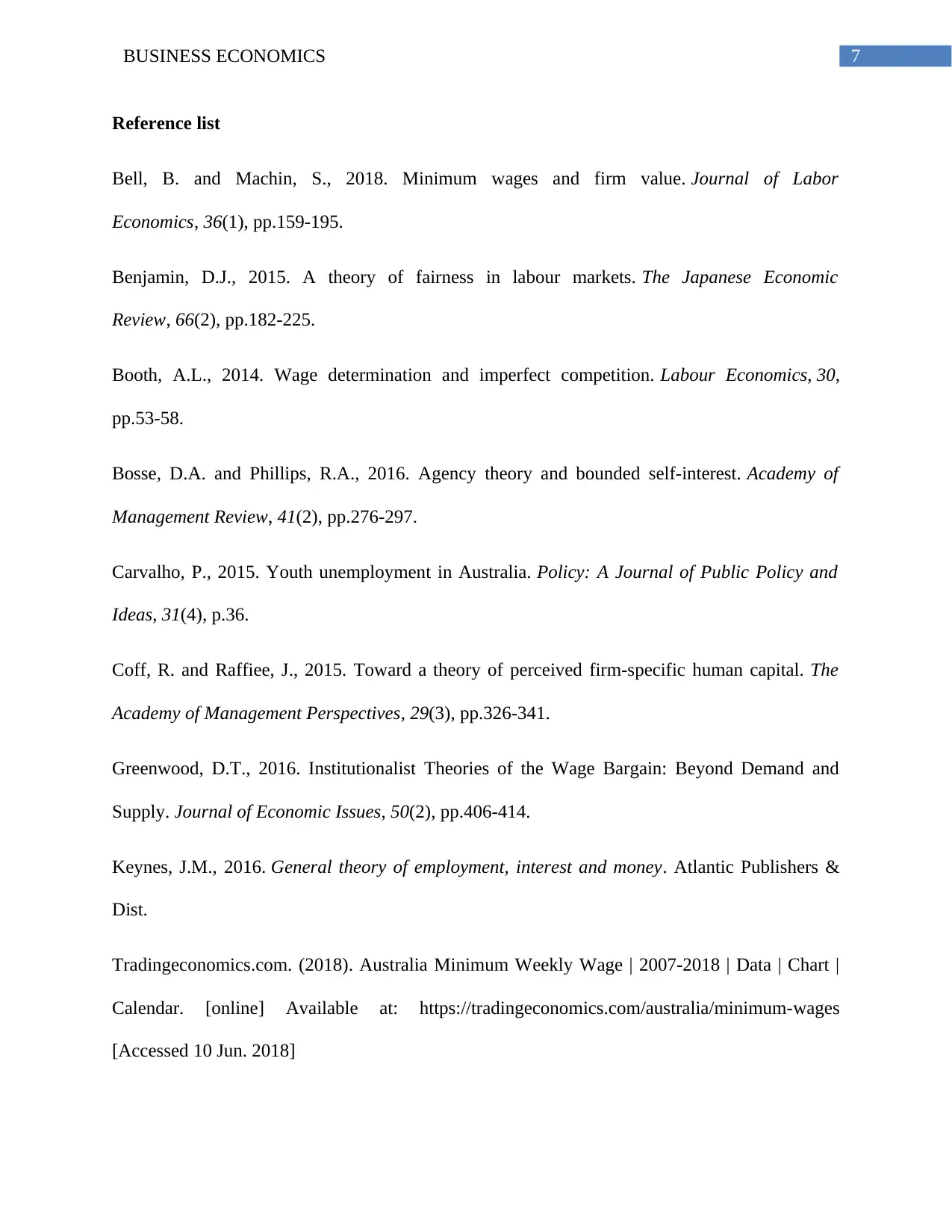
7BUSINESS ECONOMICS
Reference list
Bell, B. and Machin, S., 2018. Minimum wages and firm value. Journal of Labor
Economics, 36(1), pp.159-195.
Benjamin, D.J., 2015. A theory of fairness in labour markets. The Japanese Economic
Review, 66(2), pp.182-225.
Booth, A.L., 2014. Wage determination and imperfect competition. Labour Economics, 30,
pp.53-58.
Bosse, D.A. and Phillips, R.A., 2016. Agency theory and bounded self-interest. Academy of
Management Review, 41(2), pp.276-297.
Carvalho, P., 2015. Youth unemployment in Australia. Policy: A Journal of Public Policy and
Ideas, 31(4), p.36.
Coff, R. and Raffiee, J., 2015. Toward a theory of perceived firm-specific human capital. The
Academy of Management Perspectives, 29(3), pp.326-341.
Greenwood, D.T., 2016. Institutionalist Theories of the Wage Bargain: Beyond Demand and
Supply. Journal of Economic Issues, 50(2), pp.406-414.
Keynes, J.M., 2016. General theory of employment, interest and money. Atlantic Publishers &
Dist.
Tradingeconomics.com. (2018). Australia Minimum Weekly Wage | 2007-2018 | Data | Chart |
Calendar. [online] Available at: https://tradingeconomics.com/australia/minimum-wages
[Accessed 10 Jun. 2018]
Reference list
Bell, B. and Machin, S., 2018. Minimum wages and firm value. Journal of Labor
Economics, 36(1), pp.159-195.
Benjamin, D.J., 2015. A theory of fairness in labour markets. The Japanese Economic
Review, 66(2), pp.182-225.
Booth, A.L., 2014. Wage determination and imperfect competition. Labour Economics, 30,
pp.53-58.
Bosse, D.A. and Phillips, R.A., 2016. Agency theory and bounded self-interest. Academy of
Management Review, 41(2), pp.276-297.
Carvalho, P., 2015. Youth unemployment in Australia. Policy: A Journal of Public Policy and
Ideas, 31(4), p.36.
Coff, R. and Raffiee, J., 2015. Toward a theory of perceived firm-specific human capital. The
Academy of Management Perspectives, 29(3), pp.326-341.
Greenwood, D.T., 2016. Institutionalist Theories of the Wage Bargain: Beyond Demand and
Supply. Journal of Economic Issues, 50(2), pp.406-414.
Keynes, J.M., 2016. General theory of employment, interest and money. Atlantic Publishers &
Dist.
Tradingeconomics.com. (2018). Australia Minimum Weekly Wage | 2007-2018 | Data | Chart |
Calendar. [online] Available at: https://tradingeconomics.com/australia/minimum-wages
[Accessed 10 Jun. 2018]
1 out of 8
Related Documents
Your All-in-One AI-Powered Toolkit for Academic Success.
+13062052269
info@desklib.com
Available 24*7 on WhatsApp / Email
![[object Object]](/_next/static/media/star-bottom.7253800d.svg)
Unlock your academic potential
Copyright © 2020–2025 A2Z Services. All Rights Reserved. Developed and managed by ZUCOL.





